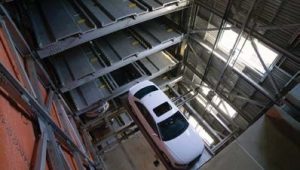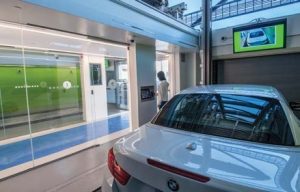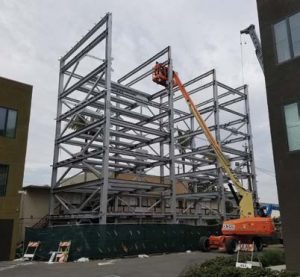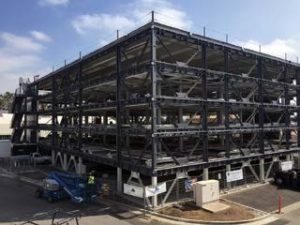Auto Auto Parking: It’s About More Than Just Parking Your Car

People Still Drive Their Own Car
In 2017, there were 267 million registered passenger vehicles in the United States, a number which dwarfs, by orders of magnitude, the number of people using driverless vehicles, ride-hailing services, carpooling, walking and other forms of transportation. For example, according to a UC Davis Institute of Transportation Studies October 2017 report, there are 2 million users of ride-hailing services, which is a meager 0.75% of the number of registered vehicles. Further, according to a 2016 report from US News and World Report, other modes of transportation to work are mere blips compared to driving yourself:
• 5% of workers commute in buses and trains
• 2.7% walk to work
• 0.6% ride a bike
The Problems with (Not) Parking
All these cars on the road must eventually get to their destination and park. Unless they have their own spot (e.g., driveway, paid stall, designated parking lot, etc.), drivers must use public or dedicated private parking. As any motorist in almost any metropolitan area will tell you, this is no easy task.
A report published last summer by INRIX, a specialist in transportation analytics, finds Americans spend an average of 17 hours per year looking for a parking spot. The wasted time jumps significantly in congested areas such as New York City (107 hrs/yr) and Los Angeles (85 hrs/yr). According to the report, all this aimless driving has major economic, social, environmental and health impacts.
First, the personal financial impact amounts to an average of nearly $350 per driver each year in fuel and time. The economic impact extends beyond individuals and to the economy as a whole. A reported 63% of survey respondents stated they avoid driving to shopping sites, airports, sports stadiums/centers and other destinations due to the challenges associated with parking. All this searching for parking results in a nearly $73 billion impact on the American economy.
To avoid potential parking tickets or fines (which annually cost Americans $2.6 billion), drivers each spend another $100 per year by overpaying for parking meters or garages to avoid these fines. This adds up to $20.4 billion in overpayments.
In addition to the wasted time and overpaying, most respondents (61%) say they’re stressed by trying to find a parking spot; almost half have missed appointments; one third have abandoned or avoided a trip due to parking problems; and one quarter say they experience road rage as a result of parking-related issues.
When all costs associated with trying to find parking are summed, Americans waste $96 billion per year, and the problem with parking will worsen as population densities and vehicle numbers increase. Something needs to be done.
Let the Machines Do It
Let’s face it: there are some things machines do better than people. From vacuuming the floor (Roomba) to warehouse picking and packing (Amazon) to vehicle chassis welding (every car maker), machines dominate repetitive, quantifiable tasks. When you break down parking into its constituent parts, you find it shares much in common with some of these other automated tasks.
There are two vastly different approaches to automated parking: The first is to modify the systems in the vehicle so it can park itself in a conventional parking spot. The car is smart, and the parking spots are not. Many automobile manufacturers have done this, and there are dozens of makes and models with some form of “parking assistance.”
The other approach is the opposite of the first: Modify the parking spots, and welcome all cars. This approach relies on smart parking spots, not smart cars.
A History of Trying
Although engineers and car manufacturers have only recently started making cars with park-assist technology, transportation and systems engineers and developers have been working on intelligent parking spaces for almost 100 years. However, only recently has automated parking really started to take hold.
Although past attempts in the 1930s and again in the 1950s struggled with success due to technology limitations, more-recent attempts in the 1990s failed because of technology: they approached it from a systems point of view and didn’t consider many of the other factors that impact success. This resulted in a number of high-profile failures from New England to Florida to Southern California.

A car being loaded into a CityLift bay at The Hive.
Modern versions of automated parking rely on technology, of course, but they start by first looking at the project itself from developers’ and municipalities’ points of view. Consideration for typical issues all developments face, such as life safety; traffic counts and queuing; noise, air and light pollution; and security all have direct impacts on the design and implementation of successful automated parking systems.
Necessity Is the Mother …
In 2007, it was these exact considerations that pushed Los Angeles-based developer Dasher Lawless into the business of designing and building an automated parking system: AUTOParkit. CEO Christopher Alan ran into density issues while planning a condominium development in Sherman Oaks, Calif.; the specific issue was related to the number of parking stalls required for the number of units planned. By code, the developer could build eight units but had enough parking space to accommodate only four units. Not satisfied with existing auto-parking systems, Alan embarked on creating his own.

A car in the CityLift loading bay at The Hive.
An automated parking garage has no need for drive aisles, elevators and stairs, lighting, ventilation, and a number of other components found in a typical parking garage (and required by existing building codes), so Dasher Lawless worked with the review agencies to append the building codes to create a new category for automated parking systems.
A similar genesis story can be told for Oakland, Calif.-based CityLift, a partnership formed in 2015 between a real estate developer and a systems manufacturer. Faced with the challenge of building marketable residential units with adequate parking, the real estate developer turned to automated parking to solve the problem encountered in many dense urban areas: too many cars and not enough parking spaces.
“As city populations get denser, it’s difficult for traditional parking to meet the needs of new development,” says CityLift CEO Scott Gable.

AUTOParkit loading bay and kiosk.
What Is Automated Parking?
There are several configuration variations for automated parking, including semi-automated and fully automated systems. Fully automated systems consist of the parking structure itself, the parking or storage bays, a loading/unloading bay, a mechanical system to move the vehicles, and the control software to run and monitor the system. Further, systems vary on the structural configuration, which has a significant impact on retrieval times.
A driver pulls into the loading bay, exits their vehicle, and (using a kiosk touch screen) initiates the parking/storage sequence. After running through a short series of safety checks, mechanical lift brings the vehicle to the proper level and the vehicle is then shuttled to an optimized storage location. When the driver returns to get their vehicle, they use a key fob or ticket or a mobile app to initiate the retrieval process: the system finds, retrieves and delivers the vehicle back to the loading bay.
Although the process is fairly straightforward, there’s a lot going on in the background to provide a seamless user experience. In these systems, cars aren’t “parked” so much as temporarily “stored.” As such, users can’t simply walk to their vehicle; they must depend on the system to park and return their car in a reliable, timely manner.

AUTOParkit lift and shuttle system.
Systems: Fast, Reliable and “ATM Simple”
Parking structures have not changed in 75 years, so everyone driving today is familiar with how to “use” them. When you park your car in a traditional parking lot or garage, you’ve likely never asked yourself “will this parking lot work?”, “how long will it take me to get my car back?” or “do I know how to use this parking garage?”
That conventional parking “works,” is easy to use, and that you can get your car back simply by going and getting it are obvious givens. However, the same can’t be said for automated parking, and these are the exact questions asked across the country by developers, governing agencies and drivers. Therefore, providers of fully automated parking systems list reliability, ease of use and speed as the most important design factors, near the top of the list alongside safety.
“Reliability is paramount,” says Shawn Adams, vice president, sales and marketing, Dasher Lawless. “Buyers [of these parking systems] are often conservative by nature, so the system has to work for drivers. We deliver on the promise that it works as designed.”
Dasher Lawless determined that a simple system meant a more reliable system. Rather than reinvent the technology wheel, Dasher Lawless turned to technology already perfected in another aspect of the automobile industry: car manufacturing. Specifically, the robotic painting of a car chassis, which involves loading cars on palettes, moving the palettes in a coordinated and predictable manner, and reliably getting the car where it needs to be when it needs to be there.

System Provider: CityLift
Project Name: The Hive
Location: Oakland, Calif.
Number of Stalls: 39
Date Opened: February 2018
The Hive Automated Parking Structure is a fully automated parking structure in Northern California. Built on a 1,600-square-foot footprint—about the size of seven parking spaces—the structure increases the parking capacity by almost six-fold to 39 vehicles. Constructed at a cost comparable to a conventional parking garage, the structure used 69% less construction material per parking space and, over its lifetime, will eliminate 91% of the greenhouse gas emissions vs. a comparable conventional parking structure.
CityLift also places a high priority on reliability, and its system evolved through 30-plus years of use in Europe and Asia to ensure it works as expected. In addition to designing, manufacturing and deploying the parking systems, CityLift also provides around-the-clock monitoring and service agreements with all its installations. Similarly, AUTOParkit systems are monitored 24/7 to ensure continuous operation, and also include a service and maintenance agreement.
“To be in this business, you must also be in the service business,” adds Gable. CityLift incorporates an automated alert system that sends a message if there is an issue. Most issues can be resolved in a few minutes by onsite employees. In other situations, CityLift service personnel will be onsite within one hour.
In addition to being reliable, auto parking systems must be fast, returning cars to their owner as quickly as possible. A brief look back at the history of automated parking facilities reveals a less-than-stellar response time, with some drivers waiting more than 45 minutes for their rides. Modern systems are designed around peak demand and deliver cars in as little as 40 seconds on the low end and a little more than two minutes on the high end.
AUTOParkit’s unique retrieval system is optimized to reduce driver wait times, especially during peak demand. Using a smartphone app or remote retrieve kiosk, drivers can initiate the retrieval process before they even get to the load bay, so their car is waiting for them when they arrive. In certain scenarios, this results in a practical wait time of zero seconds. Typical wait times at peak demand average as little as 63 seconds, with a maximum waiting time of six minutes if you’re in a queue. At the 247-stall system at Helms Bakery, for example, this means that five out of six cars are delivered with a wait time of less than one minute.
“Our retrieval system is unique,” says Alan. “System design allows for concurrent parking and retrieval transactions, allowing for multiple cars to be delivered at once and dozens of cars to be queued, ready for delivery to the load bays.”
CityLift uses several different storage configurations, each with varying delivery times. The Hive employs a “tower” configuration, with a single elevator picking and delivering vehicles to the loading/unloading bay. Delivery time for the first vehicle in the queue is 40-150 seconds, with subsequent delivery times for additional queued vehicles dependent on the number of vehicles in the queue.
Using their “aisle” configuration, CityLift can retrieve multiple vehicles simultaneously, which reduced the wait time based on the number of loading bays and lifts installed with the system. Although widely used in central China, CityLift will break ground on its first U.S.-based aisle-configured parking system later in 2018.
Although reliability is a must, and speed is an important factor, neither matter if drivers don’t know how to use the automated parking facility. Therefore, as Adams notes, the system must be “ATM-simple with no learning curve.”
After exiting their vehicle, the driver uses a touch-screen kiosk to answer a few questions (e.g., “Is everyone out of the car?”) and then sends the car on its way with a push of a button. Retrieving the car is just as easy: drivers insert a ticket (or use their key fob) to initiate retrieval, and the system returns the car to the loading bay, typically rotated to face outward, making departure quick and easy.
Masked by the user-facing simplicity is an industrial programmable logic controller (PLC) system that directs the loading, lifting, shuttling, storing and retrieving of the vehicles. PLCs are ruggedized computers originally developed for the automobile manufacturing industry. They’re used to control the parking system’s control components, providing high reliability and fault diagnostics, and they’re easy to program. The AUTOParkit system uses PLCs from Siemens, and CityLift from Schneider Electric.

System Provider: AUTOParkit by Dasher Lawless
Project Name: Helms Bakery
Location: Los Angeles
Number of Stalls: 247
Date Opened: March 2017
AUTOParkit at Helms Bakery in Los Angeles is the largest fully automated system that parks and retrieves vehicles in 40-180 seconds, allows for simultaneous transfer of up to 13 vehicles, and more than doubles the number of stalls compared to the same volume of a traditional parking structure.
The Structure
Typical parking decks and garages are massive concrete structures with columns, slabs, drive aisles and ramps, parking stalls, pedestrian walkways, stairs, and sometimes elevators. An advantage of auto parking is that many of these components are unnecessary. Because the mechanical systems move the car to the parking stall, there’s no need for drive aisles or ramps. Cars are emptied of people at the loading bay, so there’s no need for ingress or egress accommodations—or even lights. Further, because the cars aren’t running when they’re moved to storage, exhaust ventilation also is eliminated.
When these elements are removed, space is needed only to store the cars and house the mechanical and control systems. Depending on the specific use case, the steel racking used to store the cars is the structure. Coordinating with the architect and/or structural engineer, the auto parking designers determine the layout that best meets the project’s unique requirements.
Common coordination tasks include modifications to the column spacing grid. Although a typical building grid is 30- by 30-feet, the steel storage racks usually require tighter spacing. If the parking facility is free standing or otherwise independent from the building(s) it serves, designers have free range to layout the columns to best accommodate storage.
In installations where the parking and building are integrated, adjustments to the structural layout for the parking, building or both can be made. These adjustments may be the addition, deletion or movement of a column; adjusting floor-to-ceiling clearance heights; or adding members or modifying moment connections to transfer lateral loads. “The system is flexible and can be adjusted as needed to work with a wide range of buildings,” notes Adams.
Fabrication + Construction
An automated parking structure has many of the same components found in other building projects: permit requirements, architectural and structural design, utility services, foundations, steel erection, etc. However, as you mentally differentiate a typical parking structure from an automated parking system, you become aware that the building system is manufactured as much as it is constructed. The steel racking, shuttle palettes, lifts and PLC systems all are constructed and commissioned offsite and then delivered to the site for installation. This allows for high precision in fabricating the system as well as a high level of quality control. The systems themselves are assembled and tested in the factory prior to shipping to the site.
“We have a dedicated fabrication team who tests everything,” explains Gable. “The system is then shipped in containers to the site for installation.”
This continues a prefabrication trend seen across the construction industry. From precast concrete building panels and bridge box girders to HVAC and MEP systems to complete bathrooms, manufacturing and testing building components in a controlled environment and then installing them onsite is becoming more commonplace.
More than Just More Parking
In the mid 1970s during the oil shortages, the National Maximum Speed Law set the maximum speed limit to 55 mph to save gas. Although this primary goal was (mostly) achieved, other benefits also were realized, including a decrease in traffic accident fatalities. Likewise with automated parking; although the impetus for developing and deploying automated systems started with the need to address density issues and the lack of available space to provide adequate parking in urban areas, other benefits also are realized by these systems.

The CityLift parking stack under construction at The Hive.
You might think that with the addition of mechanical and control systems, 24/7 monitoring and a ready-in-the wings service team, an automated parking garage would cost much more than a traditional parking facility with the same number of parking spaces; but this is not the case. The costs of the added components of the automated systems are offset by savings in reduced construction materials (no drive aisles, ramps, pedestrian ingress/egress, etc); a smaller building footprint (40-80% reduction); and no ventilation systems (no running or idling cars creating exhaust that must be cleared). The savings are significant. For above-ground facilities, the cost to construct an automated system is about equal to that for a traditional parking garage. For automated garages with subterranean levels, the cost is actually lower due to a reduced excavation footprint.
Cost savings extend beyond the initial construction. Because facilities consist primarily of capital equipment (about 75% of the finished product), most of the project can be depreciated over seven years, compared to 29 years for capital buildings.
The additional benefits don’t end with cost savings. Personal and property safety is increased with automated parking systems. Unlike a traditional parking garage, there are no people allowed in the vehicle storage area; no one can get into a car left unlocked or break into a car, because no one can get to the cars. More important is added personal safety. According to some statistics, about 60% of all non-domestic assaults happen in parking garages. Because drivers wait in the lobby while their car comes to them, the opportunity for attackers to find isolated victims is removed.
Another benefit is less pollution: “Over the life of the facility, there is a 96% reduction in vehicle emissions because there is almost no idling,” notes Gable. Adds Alan, “Municipalities recognize that automated parking provides a significant improvement in air quality compared to a traditional structure, and that the diminishment in emissions and greenhouse gases in an urban environment is just smart planning.”
There’s one more benefit of automated parking worth mentioning: accessibility. In a typical parking facility, there are only a limited number of ADA-accessible parking spaces; in an automated parking facility, virtually all spaces are accessible. If the loading bay is ADA compliant, then all stalls are compliant for a standard-size vehicle. For oversized or other specially equipped vehicles, standard compliant stalls are provided.
Looking Ahead, “This is Awesome”
Consider a future where self-driving cars, ride-sharing and ride-hailing services make up a greater percentage of the total vehicles on the road. It’s not difficult to envision a future where there are fewer cars requiring fewer parking stalls, and the current issues addressed by automated parking aren’t as pressing.

The AUTOParkit structure under construction at Helms Bakery.
As Adams explains, “Because of the modularity and storage-like nature of AUTOParkit, the system is highly adaptable to changes in market demands.” With modification, instead of storing cars, the “parking” stalls can be used for storing bikes, marine craft or personal storage containers. In this manner, the systems fulfill a current need while remaining relevant in a changing future.
As Los Angeles City Councilman Bob Blumenfield said at the Helms Bakery grand opening, “This is awesome; this is really forward thinking.” With all the benefits provided by automated parking and the challenges it addresses, it’s only a matter of time before the technology is more widely acceptable, and automated parking is more commonplace. Awesome indeed.
About Mark Scacco
Mark Scacco, P.E., is a 25-year veteran of AEC technology and design consulting. He is an AEC Industry Consultant with Scacco LLC and can be reached via email at [email protected].


